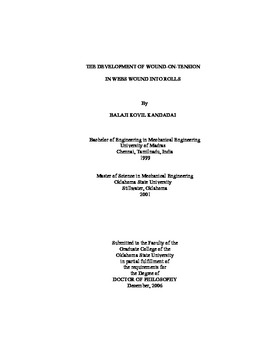| dc.contributor.advisor | Good, J. K. | |
| dc.contributor.author | Kandadai, Balaji Kovil | |
| dc.date.accessioned | 2013-12-10T18:05:17Z | |
| dc.date.available | 2013-12-10T18:05:17Z | |
| dc.date.issued | 2006-12 | |
| dc.identifier.uri | https://hdl.handle.net/11244/7799 | |
| dc.description.abstract | Scope and Method of Study: The Wound-on-Tension (WOT) is the tension in the outermost layer of a winding roll. The WOT controls the stresses in the wound roll and hence, the defects that can arise due to these stresses. Typically, rolls are wound with impinged nip rollers that exude air that might otherwise get entrained in the rolls. The nip rollers introduce tension in the web that is beyond the web line tension. In this thesis, the analysis of how the WOT is developed has been carried out. A first of a kind approach using the principles of contact mechanics and using a finite element tool has been attempted to model the nip mechanics. The surface tractions in the contact zone and the resulting behavior of slip and stick have been studied and their effect on the WOT is addressed. | |
| dc.description.abstract | Findings and Conclusions: The numerical model shows that the surface tractions in the top and the bottom surface behave differently. Due to this differential behavior in the tractions a net traction exists in the top layer. In the realm of nip loads studied, this net traction when integrated through the contact width and summed with the web tension produces the WOT in center winding. In surface winding all the WOT is nip induced and hence, the WOT is equal to the nip-induced-tension (NIT). At low nip loads, the numerical results show that the WOT is approximately equal to 'uWeb/Web.N' and at high nip loads, the WOT is much less than 'uWeb/Web.N' where, 'uWeb/Web' is the coefficient of friction between the web layers and 'N' is the nip load. Also, the results indicate that the NIT is independent of the type of winding process. The results of the parametric studies show that the model results agree with previous works. Also, the model results for the WOT and for the stresses in the contact zone were verified using experimental measurements. | |
| dc.format | application/pdf | |
| dc.language | en_US | |
| dc.rights | Copyright is held by the author who has granted the Oklahoma State University Library the non-exclusive right to share this material in its institutional repository. Contact Digital Library Services at lib-dls@okstate.edu or 405-744-9161 for the permission policy on the use, reproduction or distribution of this material. | |
| dc.title | Development of wound-on-tension in webs wound into rolls | |
| dc.contributor.committeeMember | Gipson, G. S. | |
| dc.contributor.committeeMember | Price, C. E. | |
| dc.contributor.committeeMember | Lu, H. | |
| osu.filename | Kandadai_okstate_0664D_1903.pdf | |
| osu.accesstype | Open Access | |
| dc.type.genre | Dissertation | |
| dc.type.material | Text | |
| dc.subject.keywords | wound-on-tension | |
| dc.subject.keywords | wot | |
| dc.subject.keywords | nip mechanics | |
| dc.subject.keywords | rolling contact | |
| dc.subject.keywords | wound rolls | |
| dc.subject.keywords | web handling | |
| thesis.degree.discipline | Mechanical Engineering | |
| thesis.degree.grantor | Oklahoma State University | |
